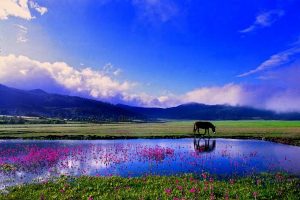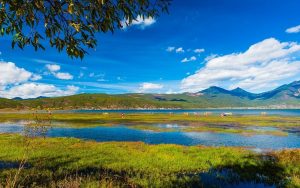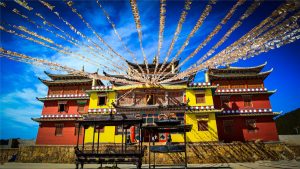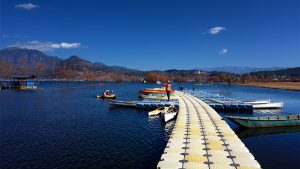Lashihai Lake in Lijiang

Chinese name: 拉市海
Location: In Hengduan Mountain Range, 10 kilometers away from the Old Town of Lijiang
Type: Nature & Lakes, Freshwater Lake
Keywords:Naxi and other minority nationalities, migrant birds
Scenic Area: 5,330 hectares
Admission Fee: Free for people
Opening Hours: All day
Altitude: about 2690 meters
Best Seasons: all year round, especially the whole winter to see birds
Recommended Visiting Time: about 1 day
Lashihai Lake Overview
Lashi Lake is in the basin in Hengduan Mountain Range, 10 kilometers away from the Old Town of Lijiang.

The warm climate makes it possible for them to pass the long winter safely. When next spring comes and flowers bloom, the birds will leave for the north for reproduction. They bring life to the villages at the foot of Jade Dragon Mountain. Especially when black-necked cranes fly over Jade Dragon in rosy clouds of dawn, you will feel that the legend about the Naxi has come true. (According to book of Dongba, the goddess Chenhong Baobai transformed herself into a crane, and carried Chongrenli’en who had survived the floods to the heaven and begged her father to let them get married. Their children then became the ancestor of Naxi people.)
Lashihai International Wetland Park was approved as a plateau wetland nature reserve in Yunnan Province in June, 1998. Since then, the nature reserve has been rehabilitated, protected and improved, which turns to be a paradise of thousands of birds consisted of 57 species, a place where biodiversity has been effectively conserved.
With an area of 5,330 hectares, Lashihai Lake is about 9.3 km long from south to north and 8.2 km wide from east to west. It is the largest lake in Lijiang County. Surrounded by the mountains, the catchment of Lashihai is about 256.6 square meters.The Rivers of Meiquan and Keluokang are merged together into Lashihai. With good quality of water, which meets water quality requirement of Grade II. It is one of the reserved drinking water sources for the city of Lijiang.
There are Naxi and other minority nationalities inhabited around Lashihai Lake, who are rich in cultural and folk customs. Zhiyun Temple situated by Lashihai Lake is regarded as one of the five temples in the city of Lijiang. It is a famous tourism spot of Tibetan Lamaism.
Where Is Lashihai Lake?
Lashi Lake, on the southern slope of the Jade Dragon Snow Mountain and 10 km (6.2 miles) from Lijiang Old Town, is part of the Lijiang – Lashihai Plateau Wetland Nature Reserve. It is a paradise for migrant birds and thousands of them stay here over winter every year. It is also the origin of the Ancient Tea Horse Road.
Despite being called Lashihai (Hai means sea), it is actually a lake cut off by Lashi Dam. Lashi is a word in ancient Naxi language, meaning a “new desolate dam”. The lake was formed in the Pliocene epoch and is around 5,330 hectares (20 square miles). It is on an altitude of about 2,437 meters (7,995 feet). Because of the lake, the wetland nature reserve was established in 1998.
Now Lashi Lake is famous for viewing migrant birds by boat and also experiencing the Ancient Tea Horse Road on horses.
What to See in Lashihai Lake?
1. Animals
At the turn of each autumn and winter, thousands of water fowls migrate afar from the north, among which there are some of national protected birds, such as Black Storks, Black Neck Cranes, Chinese Mergansers, etc. as well as great numbers of ordinary water birds like Ruddy Shelducks and Mandarin Ducks and so on. According to the records, the quantity of bird species in the area of Lashihai wetland each year amounts to 25,000 ~ 30,000, the Anatidae of Anseriformes takes the dominant. 9 from 57 species of birds in wetland are of special, rare and distinctive ones. They are distributed in the shallow lake areas in the south, west and east side of Lashihai.

2.Plants
The wetland plants in nature reserve are divided into four major life forms, among which there are 21 kinds of helophyte plant, 7 kinds of merged aquatic plant, 5 kinds of floating plant and 11 kinds benthophyte (submerged) plant. The submerged ones are among the largest portion for the building of aquatic plant community in the lake. The Ottelia acuminate is not only edible but valuable for ornamental purpose as well, which is an endangered species listed as national protected species Grade III.
3.Beauty Spring & Holy Well Source & Seven Fairies Lake
The water in Beauty Spring, the Holy Well Source and the Seven Fairies Lake is the melted snow from Jade Dragon Snow Mountain. The local Naxi people’s daily life is based on the Beauty Spring. The Holy Well Source is a holy place for Naxi people’s sacrifice. The Seven Fairies Lake is the end of the current tea-horse road. This lake is the source of Beauty Spring and Holy Well Source, as well as the water source of Lijiang Ancient Town. The water flows to this lake and then separates into different branches to Lashi Lake and Lijiang.
4.The Cliff of Dying for Love
The Cliff of Dying for Love faces the Jade Dragon Snow Mountain. The cliff is named so, because many corpses of those dying for love can found at the cliff’s bottom. There is a beautiful story concerning this cliff. It is said that a long time ago, one loving couple could not get married because of the families’ opposition. As a result, they decided to jump off the Spruce Plateau. They felt tired on the way to the plateau, so they just jumped off the cliff here, hand in hand. To commemorate them, the cliff was named as Cliff of Dying for Love.

5.Nearby Zhiyun Temple
In addition to these popular activities, the local Zhiyun Temple, a quiet place without crowds, is a great option for travelers. The temple is located to the north of the Lashi Lake. Built in 1727, it was the residence of two Living Buddhas and has five yards now. Except for some Buddha statues, visitors can find many daily use items of the Living Buddha, such as clothes, bronze seals, ivory chopsticks and clothes for religious rites. A gingko, an old pine tree and an oriental cherry in the yard all witness the development of this temple. The temple now has free entry.
【Bird Watching】Best time to visit Lashi Lake is Dec. It is the best time to have the bird watching. And birds can be saw easily in the morning and the evening.
【Sightseeing】The most beautiful place of Lashi Lake will be Mei Spring. Sourcing from the conjunction of Wohu Mountain and Beidou Mountain, spring water flows from jagged ricks, as green as the top level jade, the bottom can be seen even the water level with 6 meters depth.
【What to Eat】Roast fish can be a try. When sailing boat on the lake, you can buy some roast fish.
【Horse Riding & Boating】Many horse ranches can be found in Lashi Lake, according to different lengths will be charged differently, from CNY 100 to 300, including a riding and a boating and a meal
Recommend activities at Lashihai Lake
Boating on the Lashihai Lake
The canoe of Naxi is made of a whole trunk of one tree, try to show the biggest smile as you can, borrow a canoe from local villages, and ride it to the center of the lake!
Vist local Naxi families in the villages surrounding the lake
Many typical villages have not been polluted by mordern tourism, lots of things to see for local interest.
Biking from Dayan town to Lashihai Lake
Ask a local person to lead the way, lots of turns on the countryside paths.
Bird watch in winter time
Ask local persons for the time when is the perfect time.
Enjoying the Ancient Tea Horse Road on Horse
Riding to experience the Ancient Tea and Horse Road is the other must-try activity to get close to the local special culture. The ancient Tea and Horse Road, similar to the Silk Road, was an important trading route in the southwestern part of China and the horse was a significant form of transport on this route. Different from the tall and big horses on the grassland, the horses in Yunnan are small, but good at long-distance transporting. Consequently, it may feel different during the ride.
Presently, only a small section of this old road is available for traveling. Visitors will pass some Naxi villages, virgin forest, the Beauty Spring (Mei Quan), the Holy Well Source, the Cliff Dying for Love and the Seven Fairies Lake.
How to get to Lashihai Lake
1. Take bus 31 or 32 from Lijiang Old Town to Shidi Gongyuan.
2. Hire a car to Lashi Lake. The car trip takes about 30 minutes and the fare is around CNY 30 to 50.
3.Go to parking lot near Zhongyi Market of Lijiang Ancient Town, you can see mini vans with signs to different villages of Lashi Lake, choose the right one, generally costing CNY 4 – 5 one way.
4.Renting a bike and cycling to the Lashi Lake by yourself, about 1 hour, moderating level, cost CNY 100 – 150 renting bike per day.
Recommended Visiting Tours
Lashihai Lake is a famous wetland park and entertainmen place in Lijiang. Ride a horse to experience the Ancient Tea and Horse Road and take a boat on the Lashihai Lake is the must-try activities to get close to the local special culture.
1 Day Lashihai Lake Boat Cruise and Horse Riding Tour along the Ancient Tea Horse Road
1 Day Lijiang Cycling Tour from Lijiang Old Town to Lashihai Lake and Zhiyun Monastery
Lashihai Lake Accommodation
Generally the tourists who pay a visit to Lashihai Lake will choose to stay in Lijiang Old Town. There are many characteristics hotels, guesthouses and inns to choose in Lijiang Old Town. People who want a more beautiful living environment can also choose to live in the Shuhe Ancient Town or the tranquil Baisha Old Town. Anyhow, there are lots of agritainments near the scenic spots where you can choose to stay.
Travel Tips for Lashihai Lake

1. For hiring a car, you are advised to order directly from the owner of the hostel, or book with a reliable local tour agency. Their services usually include the car to the lake, horse riding and bird viewing tours. Booking with them directly will save money and avoid you being cheated.
3. Hiring a car to Zhiyun Temple for a single journey costs about CNY 25.
4. Travelers who want to ride need to bring some clothes easy for riding. Put your personal things and valuables in a safe place. You must listen to the grooms’ orders. Please hold the rain tight to avoid falling off when the horse is running. Sunglasses and sun cream are necessary.

 7 Days GolfingTour
7 Days GolfingTour
 8 Days Group Tour
8 Days Group Tour
 8 Days Yunnan Tour
8 Days Yunnan Tour
 7 Days Shangri La Hiking
7 Days Shangri La Hiking
 11 Days Yunnan Tour
11 Days Yunnan Tour
 6 Days Yuanyang Terraces
6 Days Yuanyang Terraces
 11 Days Yunnan Tour
11 Days Yunnan Tour
 8 Days South Yunnan
8 Days South Yunnan
 7 Days Tea Tour
7 Days Tea Tour
 8 Days Muslim Tour
8 Days Muslim Tour
 12 Days Self-Driving
12 Days Self-Driving
 4 Days Haba Climbing
4 Days Haba Climbing
 Tiger Leaping Gorge
Tiger Leaping Gorge
 Stone Forest
Stone Forest
 Yunnan-Tibet
Yunnan-Tibet
 Hani Rice Terraces
Hani Rice Terraces
 Kunming
Kunming
 Lijiang
Lijiang
 Shangri-la
Shangri-la
 Dali
Dali
 XishuangBanna
XishuangBanna
 Honghe
Honghe
 Kunming
Kunming
 Lijiang
Lijiang
 Shangri-la
Shangri-la
 Yuanyang Rice Terraces
Yuanyang Rice Terraces
 Nujiang
Nujiang
 XishuangBanna
XishuangBanna
 Spring City Golf
Spring City Golf
 Snow Mountain Golf
Snow Mountain Golf
 Stone Mountain Golf
Stone Mountain Golf












